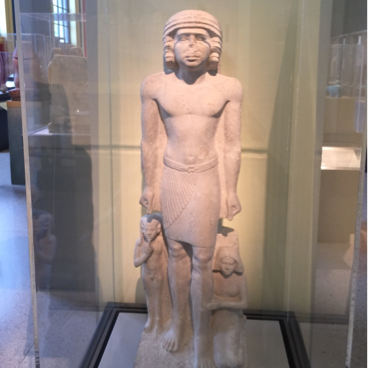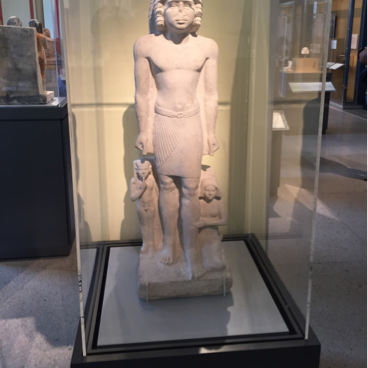

Irukaptah and his Family, ca. 2455–2425 B.C.E. Limestone, pigment, 29 × 10 × 9 1/2 in., 60 lb. (73.7 × 25.4 × 24.1 cm, 27.22kg). Brooklyn Museum, Charles Edwin Wilbour Fund, 37.17E. Creative Commons-BY (Photo: Brooklyn Museum, 37.17E_SL1.jpg)

Irukaptah and his Family, ca. 2455–2425 B.C.E. Limestone, pigment, 29 × 10 × 9 1/2 in., 60 lb. (73.7 × 25.4 × 24.1 cm, 27.22kg). Brooklyn Museum, Charles Edwin Wilbour Fund, 37.17E. Creative Commons-BY (Photo: , 37.17E_edited_SL1.jpg)

Irukaptah and his Family, ca. 2455–2425 B.C.E. Limestone, pigment, 29 × 10 × 9 1/2 in., 60 lb. (73.7 × 25.4 × 24.1 cm, 27.22kg). Brooklyn Museum, Charles Edwin Wilbour Fund, 37.17E. Creative Commons-BY (Photo: , 37.17E_detail_edited_SL1.jpg)

Irukaptah and his Family, ca. 2455–2425 B.C.E. Limestone, pigment, 29 × 10 × 9 1/2 in., 60 lb. (73.7 × 25.4 × 24.1 cm, 27.22kg). Brooklyn Museum, Charles Edwin Wilbour Fund, 37.17E. Creative Commons-BY (Photo: Brooklyn Museum, CUR.37.17E_erg2.jpg)

Irukaptah and his Family, ca. 2455–2425 B.C.E. Limestone, pigment, 29 × 10 × 9 1/2 in., 60 lb. (73.7 × 25.4 × 24.1 cm, 27.22kg). Brooklyn Museum, Charles Edwin Wilbour Fund, 37.17E. Creative Commons-BY (Photo: Brooklyn Museum, 37.17E_threequarter_right_bw.jpg)

Irukaptah and his Family, ca. 2455–2425 B.C.E. Limestone, pigment, 29 × 10 × 9 1/2 in., 60 lb. (73.7 × 25.4 × 24.1 cm, 27.22kg). Brooklyn Museum, Charles Edwin Wilbour Fund, 37.17E. Creative Commons-BY (Photo: Brooklyn Museum, 37.17E_NegI_glass_bw_SL4.jpg)

Irukaptah and his Family, ca. 2455–2425 B.C.E. Limestone, pigment, 29 × 10 × 9 1/2 in., 60 lb. (73.7 × 25.4 × 24.1 cm, 27.22kg). Brooklyn Museum, Charles Edwin Wilbour Fund, 37.17E. Creative Commons-BY (Photo: Brooklyn Museum, 37.17E_NegJ_glass_bw_SL4.jpg)
Irukaptah and his Family
Egyptian, Classical, Ancient Near Eastern Art
On View: Old Kingdom to 18th Dynasty, Egyptian Galleries, 3rd Floor














































